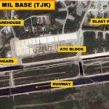
Dushanbe and Moscow Disagree over Russia’s Use of Ayni Airbase
Publication: Eurasia Daily Monitor Volume: 8 Issue: 28
By:

Speaking to journalists on January 27, Tajikistan’s Foreign Minister, Khamrokhon Zarifi, announced that Dushanbe and Moscow will continue talks on Russia’s possible use of the recently renovated Ayni airfield, 15 miles (25 kilometers) west of the Tajik capital. According to Zarifi, the two countries have different views on “certain issues” related to the use of the facility (www.khovar.tj, January 27).
Zarifi also restated the Tajik government’s position that Russia is the only country with which Dushanbe is holding talks on the airfield (Shabakai Yakum TV, January 27). The facility hosted a Soviet helicopter repair facility before falling into disuse after Tajikistan’s independence. Between 2004 and 2010, India helped to refurbish the airfield, spending about $70 million on upgrading the runway, building and equipping hangars and administrative buildings (www.khovar.tj, September 3, 2010). India’s renovation of the Ayni airfield prompted speculation that New Delhi intended to use the facility as its first ever foreign airbase. However, neither Dushanbe nor New Delhi have confirmed India’s interest in the airfield, particularly amidst diplomatic protests by Pakistan and pressure from Russia, which continues to view Tajikistan as part of its sphere of “privileged interest.”
There has also been extensive media speculation about the United States and France’s interest in the possible use of the Ayni airfield. The Russian media claim that in 2009, President Rahmon offered the use of the facility to the US in support of its antiterrorist operations in Afghanistan (Nezavisimaya Gazeta, July 7, 2009). A February 2010 cable from the US embassy in Dushanbe, disclosed recently by WikiLeaks, confirmed that Dushanbe had indeed proposed to host a US airbase in the country (https://www.guardian.co.uk/world/us-embassy-cables-documents/248969). According to the Tajik media, France also considered the Ayni airfield as an alternative to the Dushanbe airport for its air force contingent (Asia-Plus, October 29, 2008).
Officially, however, the Tajik government has never confirmed discussing the use of the Ayni airfield with any country other than Russia. Moscow has long considered deploying combat aircraft at Ayni to strengthen its military presence in the region. Moscow’s interest in securing an airbase in Tajikistan has only strengthened after Russia’s short war with Georgia in 2008 demonstrated the importance of airpower in achieving its military goals (EDM, November 18, 2008).
Dushanbe first offered the Ayni airfield to Moscow in 2004 free of charge as the two countries signed a number of military and investment agreements. Moscow, however, was slow in responding to the offer, with Russia’s defense ministry preoccupied with setting up the newly acquired Kant airbase in Kyrgyzstan. The relationship between Tajikistan and Russia soon deteriorated because of Moscow’s failure to deliver the promised investment in the Rogun dam project and its adoption of what many Tajiks saw as a pro-Uzbek stance on water management issues in Central Asia (https://www.cacianalyst.org/?q=node/5224). As a result, Dushanbe reconsidered its position vis-à-vis Russia’s possible use of the airbase, making it contingent on rent payment or investments.
The two countries reportedly reached an agreement on the joint use of the facility during Russian President Dmitry Medvedev’s visit to Dushanbe in October 2008. Although the terms of the deal have not been made public, the Russian media reported that Moscow would soon deploy five Su-25 ground attack aircraft (NATO designation: Frogfoot) and several Mi-24 and Mi-8 helicopters at Ayni and would help complete the renovation of the facility (Nezavisimaya Gazeta, October 28, 2008).
The agreement has not yet materialized, with the two countries reportedly having major disagreements on agreeing to the details of the deal. The differences apparently stem from Moscow’s intention to secure exclusive use of the airbase, while Dushanbe insists on joint use. For Russia, sole use of the facility is a matter of “national prestige” and security of the long-term military deployment (Asia-Plus, October 30, 2008). Dushanbe, however, views the airfield as a training ground for its decrepit air force and cannot agree on anything other than joint use (www.khovar.tj, September 3, 2010).
In addition to these differences, the two countries cannot agree on the payments for the use of the airbase. Moscow reportedly claims that it has already given generous military support to Tajikistan and should be granted free access to the Ayni airfield. Since the late 1990’s, Russia has repaired Tajikistan’s radar and anti-aircraft systems, donated four Mi-24 and two Mi-8 helicopters, four L-39 jet training aircraft, as well as other equipment and munitions to the Tajik defense ministry. Russian experts estimate the cost of military equipment and munitions donated to Tajikistan at about $1 billion. Dushanbe, however, claims that most of the donated equipment is dilapidated, with about 40 percent not fit for further use (Nezavisimaya Gazeta, September 15, 2009).
According to Russian sources, Dushanbe wants Moscow to pay $125 million per year for the rent of its military base in Tajikistan, including the Ayni airfield, or contribute a comparable amount in military aid (Nezavisimaya Gazeta, January 19). These estimates appear unreasonably high. By comparison, the US pays only $60 million annually for renting the Manas airbase in Kyrgyzstan. It remains to be seen whether Moscow will be able to resolve its disagreements with Dushanbe and deploy combat aircraft at Ayni. China’s rapidly growing influence in Tajikistan might force Russia to speed up the negotiations and meet, at least partially, Dushanbe’s demands to secure access to the airbase.




